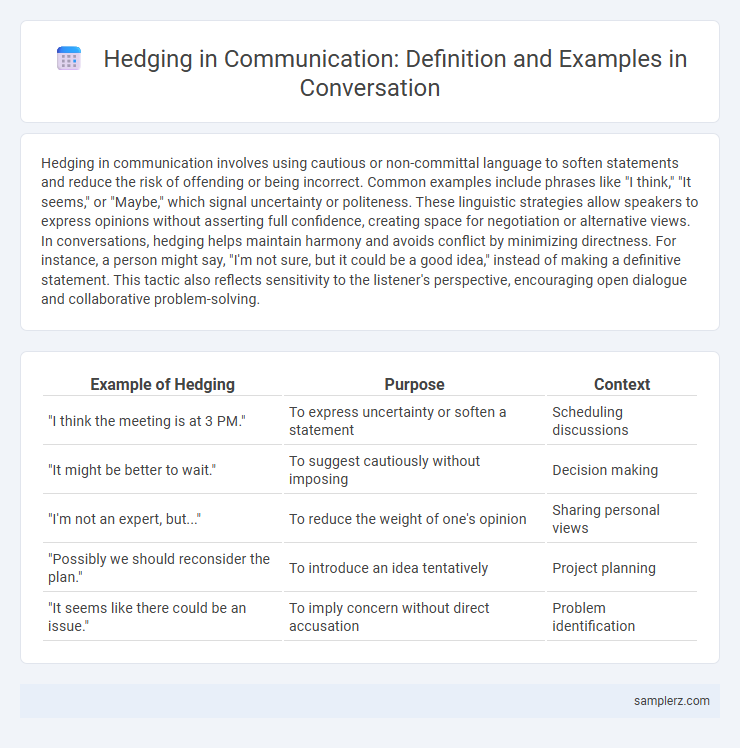Hedging in communication involves using cautious or non-committal language to soften statements and reduce the risk of offending or being incorrect. Common examples include phrases like "I think," "It seems," or "Maybe," which signal uncertainty or politeness. These linguistic strategies allow speakers to express opinions without asserting full confidence, creating space for negotiation or alternative views. In conversations, hedging helps maintain harmony and avoids conflict by minimizing directness. For instance, a person might say, "I'm not sure, but it could be a good idea," instead of making a definitive statement. This tactic also reflects sensitivity to the listener's perspective, encouraging open dialogue and collaborative problem-solving.
Table of Comparison
| Example of Hedging | Purpose | Context |
|---|---|---|
| "I think the meeting is at 3 PM." | To express uncertainty or soften a statement | Scheduling discussions |
| "It might be better to wait." | To suggest cautiously without imposing | Decision making |
| "I'm not an expert, but..." | To reduce the weight of one's opinion | Sharing personal views |
| "Possibly we should reconsider the plan." | To introduce an idea tentatively | Project planning |
| "It seems like there could be an issue." | To imply concern without direct accusation | Problem identification |
Common Phrases Used for Hedging in Conversation
Common phrases used for hedging in conversation include "I think," "it seems," and "possibly," which help soften statements and express uncertainty or politeness. Phrases like "kind of," "sort of," and "maybe" also function to reduce the forcefulness of claims, allowing speakers to appear less committed to their assertions. These hedging expressions play a crucial role in managing interpersonal dynamics and maintaining conversational diplomacy.
Classic Hedging Expressions in Everyday Speech
Classic hedging expressions in everyday speech include phrases like "I think," "it seems," and "perhaps," which soften statements and reduce potential conflict. These linguistic tools help speakers express uncertainty or politeness while maintaining conversational flow. Such hedges are essential for managing interpersonal dynamics and mitigating the risk of offending listeners.
Polite Ways to Hedge Your Statements
Using phrases like "I think," "It seems," or "Perhaps" allows speakers to express opinions without asserting absolute certainty, which maintains politeness in conversations. Hedging phrases such as "In my experience" or "It might be possible" soften statements and invite openness to alternative viewpoints. These techniques reduce the risk of offending others while facilitating respectful and effective communication.
Examples of Hedges to Soften Opinions
Phrases like "I think," "it seems," and "perhaps" serve as hedges to soften opinions in conversations, reducing the risk of offending or sounding too assertive. Using expressions such as "maybe," "kind of," or "a bit" helps convey uncertainty or politeness, making statements less direct and more collaborative. These linguistic strategies enhance effective communication by allowing speakers to present ideas tentatively and invite dialogue.
Using Modal Verbs as Hedges in Dialogue
Using modal verbs such as "might," "could," and "may" in conversation softens statements and introduces uncertainty, helping speakers avoid direct assertions. For example, saying "It might be helpful to review the report" rather than "You should review the report" protects the speaker from sounding too forceful. This hedging technique enhances politeness and facilitates more open, collaborative communication.
Indirect Language: Hedging for Diplomacy
Using indirect language, such as hedging phrases like "it seems" or "perhaps we could consider," softens statements to maintain diplomacy in conversation. This approach minimizes the risk of offending others by avoiding blunt assertions and encourages open dialogue. Indirect language hedging is especially effective in sensitive discussions where preserving relationships and mutual respect is crucial.
Academic vs. Everyday Hedging Examples
Academic hedging often involves phrases like "the data suggests" or "it is possible that," which soften claims to acknowledge uncertainty and encourage critical evaluation. Everyday hedging in conversations typically includes expressions such as "kind of," "maybe," or "I think," allowing speakers to convey opinions without full commitment. Both forms of hedging serve to manage interpersonal dynamics and reflect varying levels of certainty in different communication contexts.
Subtle Hedges for Managing Disagreement
Subtle hedges in communication, such as phrases like "I might be wrong, but," "It seems to me," or "Perhaps we could consider," help manage disagreement by softening statements and reducing direct confrontation. These linguistic strategies create space for alternative views, maintaining politeness and fostering cooperative dialogue. Using such hedges effectively facilitates smoother interactions and preserves relationships during differing opinions.
Sentence Starters for Conversational Hedging
Sentence starters for conversational hedging often include phrases like "I think," "It seems," and "Perhaps," which soften statements by indicating uncertainty or openness to other perspectives. Using expressions such as "I'm not sure, but," "It could be that," or "In my opinion," helps maintain politeness and reduces the risk of confrontation during discussions. These hedging strategies enhance effective communication by allowing speakers to present ideas tentatively, promoting collaborative dialogue.
Cultural Variations in Hedging Language
Hedging language varies significantly across cultures, influencing how speakers soften statements to maintain politeness or avoid conflict. For instance, Japanese communication frequently employs indirect phrasing and modal verbs like "desu ka" to express uncertainty or humility, while American English favors phrases such as "I think" or "maybe" for similar effects. Understanding these cultural variations in hedging enhances cross-cultural communication by respecting differing social norms and expectations.

example of hedging in conversation Infographic
 samplerz.com
samplerz.com